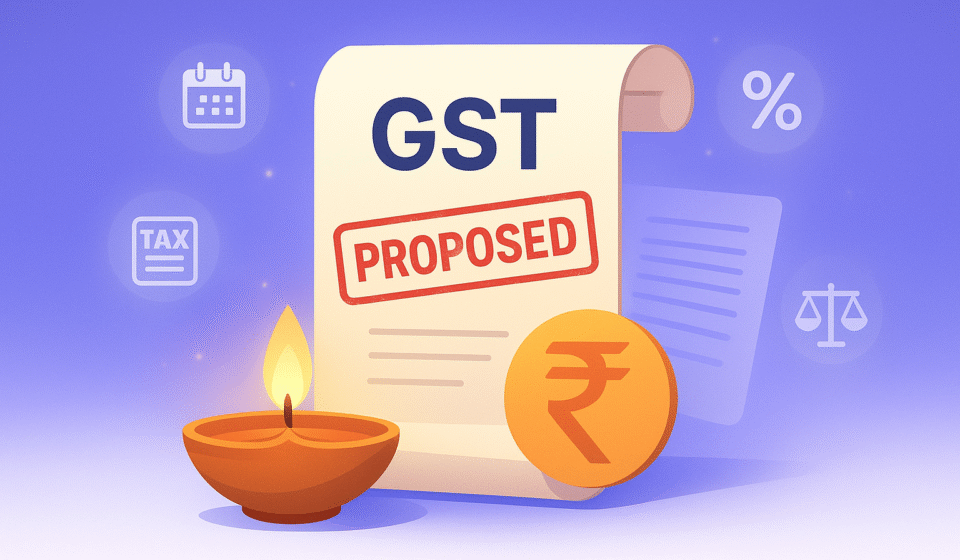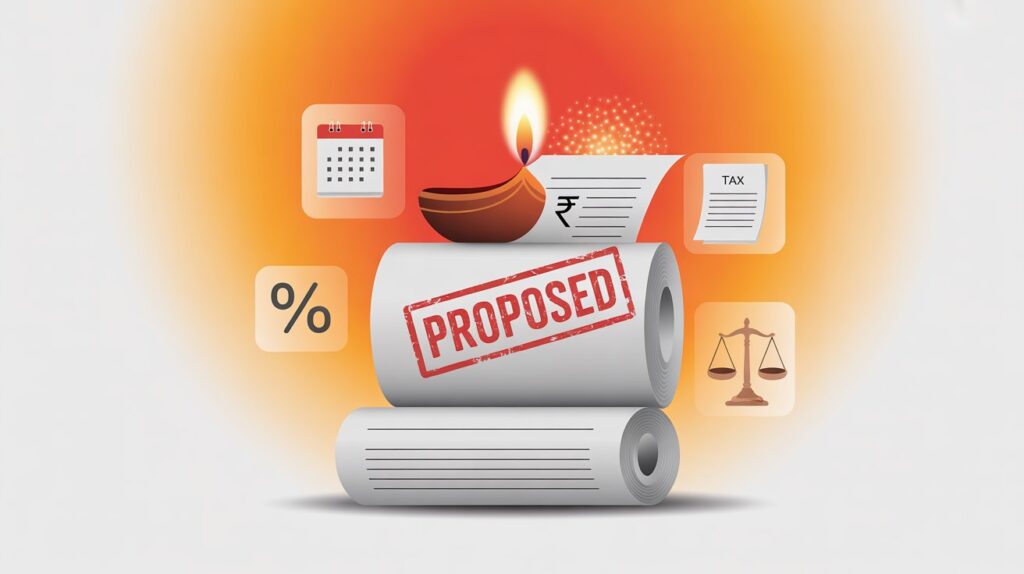
GST reforms 2025 – New rates, slabs and what businesses & consumers must know
GST reforms 2025: What’s proposed, what’s confirmed, who wins or loses, fiscal impact, state concerns and practical takeaways for consumers and businesses.
Table Of Content
- Introduction
- What was announced (confirmed vs proposed)
- Why change now – policy rationale
- What the proposed new slabs mean (old vs proposed table)
- Fiscal impact & states’ concerns
- Implementation timeline and process
- Sectoral winners & losers – practical takeaways
- Business & compliance impact – 7-point readiness checklist for CFOs
- What taxpayers (and retailers) should do now
- Expert views & quotes
- Conclusion & CTA
- FAQs
- Have GST rates changed now?
- Will my grocery bill fall?
- Who decides compensation for states?
- When will changes be implemented?
- How will input tax credit work under new slabs?
Introduction
GST reforms 2025 is the shorthand for a proposed reforms in India’s GST regime announced by the Prime Minister on 15 August 2025 and actively discussed in subsequent government meetings. The package aims to simplify slabs (a two-tier push), lower taxes on many everyday items and rework sin/luxury levies – but the scale, timing and fiscal trade-offs remain under negotiation. This guide explains what was proposed, what’s confirmed, who stands to gain or lose, the likely fiscal impact, state concerns, implementation steps and practical takeaways.
What was announced (confirmed vs proposed)
Confirmed (official/public):
- The Centre announced plans for next-generation GST reforms to be unveiled by Diwali; a PIB/PMO statement recorded the intention to reduce the tax burden on daily-use items. This is an announcement of intent, not a legal change.
- The Government has constituted or advanced deliberations through a Group of Ministers (GoM) and scheduled a consequential 56th GST Council meeting for 3–4 September 2025. The GST Council notice confirms the meeting dates.
Reported / proposed (media and insider reporting):
- Move to a two-slab model: principal slabs of 5% and 18%, with a higher rate (~40%) for sin/luxury items (e.g., cigarettes). These are widely reported proposals (not yet Council notifications).
- Major reclassification of items (many current 12% items to shift to 5%; many 28% items to 18% or taxed via separate sin-levy). These lists are reported in press coverage and trade notes; final lists await GST Council approval.
Bottom line: announcements show intent and GoM support, but no legal change is final until GST Council recommendations are notified by CBIC. Do not treat press lists as law until CBIC notifications appear.

Why change now – policy rationale
Officials and economists say the reforms aim to: simplify a complex multi-slab structure, reduce effective prices for households ahead of festival season, boost consumption and growth, and potentially ease inflationary pressures. The move also responds to political and macro pressures (trade frictions, U.S. tariffs). Analysts expect short-term demand stimulus if cuts are enacted.
Proponents argue simplification reduces compliance costs and removes odd exceptions (e.g., seemingly arbitrary differences across variants). Critics and many state governments warn of substantive revenue loss and the need for a durable compensation mechanism.
What the proposed new slabs mean (old vs proposed table)
| Old slabs (typical) | Examples | Proposed slabs (reported) | Potential beneficiaries |
|---|---|---|---|
| 0% | Basic essentials | 5% (broad) | Food staples, many FMCG items, some medicines (12% -> 5%) |
| 5% | Essentials, staple processed foods | 5% (retained) | Same, wider coverage |
| 12% | Many processed foods, consumer items | 5% | Butter, juices, many personal-care items (reported) |
| 18% | Large share of services & goods | 18% (standard) | Many goods that were 18 remain here |
| 28% + cess | Cars, ACs, luxury goods (+ compensation cess) | 18% or taxed via special sin levy (40%) | Small cars likely 18%; luxury/sin goods kept high (40%) |
Examples: press reports suggest small cars may move 28% -> 18% and many 12% consumer items (toothpaste, soaps, some foods) may move to 5%. Exact item lists will follow GoM / GST Council recommendations.
Fiscal impact & states’ concerns
Estimates vary widely:
- Reuters / state ministers: states estimate annual revenue losses of ₹1.5–2.0 lakh crore (₹150,000–200,000 crore) and warn states will bear over 70% of the burden.
- Financial Express / officials: a more conservative official/FE figure previously cited ~₹60,000 crore on an annualised basis as one internal estimate, though independent analysts (Nomura, IDFC) produce higher numbers.
Why states worry: GST is a major state revenue source. A large cut shrinks state receipts, complicating social spending and development plans. States are demanding compensation mechanisms – either a continuation of compensation cess (which is expiring) or a new dedicated levy on sin/luxury goods whose proceeds are passed to states. Several states have sought multi-year compensation guarantees.
Implementation timeline and process
- GoM deliberation: Group of Ministers studies options and recommends a package. (GoM has reportedly approved the centre’s rate rationalisation in principle.)
- GST Council meeting: Council (centre + state FMs) deliberates – 56th meeting scheduled 3–4 Sept 2025. Council approval is required.
- CBIC notifications / rules: Post-Council, CBIC issues notifications, tariff schedules and transitional rules.
- Operational rollout: GSTN, ERP and invoicing updates; transition windows for stocks and input tax credit (ITC) adjustments. Expect days–weeks to months depending on the scale.
Sectoral winners & losers – practical takeaways
Winners (likely):
- FMCG & personal care: many items could drop from 12/18% to 5%.
- Consumer durables & small cars: lower GST could boost demand (reported auto sector optimism).
- Construction materials / tiles: lower rates can stimulate housing demand.
Potential losers / watchpoints:
- States (revenue hit) unless compensated.
- Sin goods & luxury: likely taxed at higher nominal rate (reported ~40%) or through special levies – producers/consumers could face higher effective tax.
Market reaction: markets rallied on the announcement (autos, consumer stocks leading gains) in the immediate aftermath; investor sentiment will depend on clarity and the fiscal resolution.
Business & compliance impact – 7-point readiness checklist for CFOs
- Map SKU lists to proposed slabs and identify high-impact products.
- Run ITC transition scenarios and estimate working capital needs.
- Update ERP/POS tax codes & test GSTN return sequences.
- Communicate pricing & inventory strategy with supply chain partners.
- Engage with tax counsel on transitional provisions (stock, invoices).
- Prepare customer communications explaining pass-through timing.
- Model fiscal impact on margins and cash flows; inform investors/boards.
What taxpayers (and retailers) should do now
- Consumers: For big-ticket purchases (AC, TV, car), consider waiting for official notifications if purchase is not urgent.
- Small retailers: Avoid bulk buys of slow-moving inventory until transitional rules are clear.
- Tax professionals: Watch CBIC notifications for transitional ITC rules and update client advisories promptly.
Expert views & quotes
- Reuters reported that state ministers warned the reforms could lead to annual revenue shortfalls of ₹1.5–2 trillion and urged a compensation mechanism. Krishna Byre Gowda (Karnataka revenue minister) said large revenue losses could destabilise state finances.
- Financial Express/Nomura analysts estimated possible collections shortfalls at about ₹1.5 lakh crore (reported). Other official sources noted smaller internal estimates – the range is wide.
Conclusion & CTA
The GST reforms 2025 could simplify the tax structure and lower prices for many goods, but the trade-offs – especially state revenue shortfalls – make consensus difficult. The next decisive moment is the GST Council meeting on 3–4 Sept 2025; until CBIC issues notifications, businesses and consumers should plan but not assume the changes.
Read more about : GST
FAQs
Have GST rates changed now?
No – as of 29 Aug 2025 the reforms are proposed and under GST Council deliberation. No legal change is final until CBIC notifications are issued.
Will my grocery bill fall?
Possibly for items moved from 12% -> 5% or 18% -> 5%. Exact savings depend on final item lists and whether sellers pass through the cut.
Who decides compensation for states?
The GST Council – the Centre and states must agree on compensation arrangements; states have asked for multi-year guarantees or new levies on sin/luxury items.
When will changes be implemented?
Timeline depends on Council approval (meeting 3–4 Sept 2025), then CBIC notifications and operational rollout (weeks to months). Goods and Services Tax Council
How will input tax credit work under new slabs?
Transitional ITC rules will be issued by CBIC; businesses must track input credits and invoices for the pre- and post-notification periods. Expect clarifying circulars. Goods and Services Tax Council



